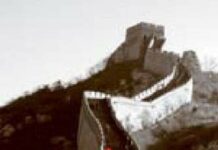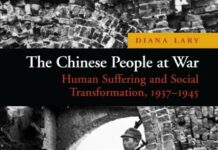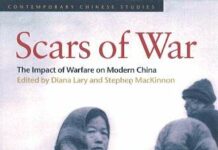
Ebook Info
- Published: 2007
- Number of pages: 242 pages
- Format: PDF
- File Size: 3.93 MB
- Authors: Diana Lary
Description
Twenty-first century China is emerging from decades of war and revolution into a new era. Yet the past still haunts the present. The ideals of the Chinese Republic, which was founded almost a century ago after 2000 years of imperial rule, still resonate as modern China edges towards openness and democracy. Diana Lary traces the history of the Republic from its beginnings in 1912, through the Nanjing decade, the warlord era, and the civil war with the Peoples’ Liberation Army which ended in defeat in 1949. Thereafter, in an unusual excursion from traditional histories of the period, she considers how the Republic survived on in Taiwan, comparing its ongoing prosperity with the economic and social decline of the Communist mainland in the Mao years. This introductory textbook for students and general readers is enhanced with biographies of key protagonists, Chinese proverbs, love stories, poetry and a feast of illustrations.
User’s Reviews
Reviews from Amazon users which were colected at the time this book was published on the website:
⭐The text is general, and dated. A lot has happened since this was published. Also, I live in the Republic of China and the 國民黨 spell their name Kuomintang (KMT), not Guomindang (GMD). One would think an authority on the topic would know that. But I guess strict adherence to the PRC’s pinyin is more important than what the actual 國民黨 print on tshirts.
⭐Professor Lary’s fast-paced retelling of the history of modern China offers a refresher course in one of the most complex stories of the 20th century, a narrative often lost in the fuller accounts of the tumultuous early decades of the Chinese republic. Her conception that the history of the Republic of China has continuity from the Chinese mainland to Taiwan is a welcome correction to the standard accounts which drop the narrative with the establishment of the People’s Republic in 1949.This is especially relevant now that the ROC has been given new life with the return to power of the Chinese Nationalist Party (Kuomintang or KMT) on Taiwan in March this year. The rehabilitation of Chiang Kai-shek by the Chinese government (begun more than 20 years ago) and the growing interest in the KMT experience on Taiwan among Chinese scholars as the story of Taiwan’s democracy becomes better known on the Chinese mainland gives urgency to this project.However, Lary does not realize her goal, if that is a history of republican China as seen through the ideas of Sun Yat-sen and the institutions he inspired and created, which survived the Chinese civil war and relocated to Taiwan. Her summary of history is a rough first draft, a skeleton around which could be written a more idea-based account of the republican principles and traditions, especially how the KMT came to adapt and apply on Taiwan the legacy of Sun and his followers which was so poorly realized in China itself.Most disappointing is Lary’s last chapter on Taiwan since 1949. The space allotted is too brief, the generalizations too sloppy, and the history too spotty to give anything but a general and sometimes confused understanding of what has happened on the island in the past half century. And there are glaring holes. These include the crucial role played by Lee Teng-hui in moving the KMT toward democracy during the 1990s, the complex role and influence of the United States, and the story of a worldwide dissident movement which conflated democracy and independence and helped to keep alive (and funded) the island’s impassioned opposition movement, and so on.The economic history of the island is also confusingly told, with dubious interpretations and omissions, such as the heavily over-capitalized financial markets that emerged in the late 1980s and the evolution of a capital and technology exporting economy in the past 20 years which contributed hugely to China’s own modernization.In trying to summarize the island’s development under martial law and where it is today, while making comparisons with contemporary China — sometimes all in the same paragraph, meaningful facts and accurate interpretations get lost.There is little understanding of the breadth and intensity of Taiwanese nationalism and of the conflicting attitudes toward China among the island’s political elite, with such simplistic comments as “Taipei is philosophical about Beijing’s attitudes.” (p. 209)There are some embarrassing errors of fact. It was Lin Yi-hsiung, one of Taiwan’s most famous dissident leaders, not the disgraced Shi Ming-teh, whose mother and twin daughters were murdered in 1980, most likely by KMT thugs. (p. 201)Even more than the earlier chapters, where the history is especially rich, the sidebars on famous people or key topics in the Taiwan chapter are too arbitrary to add meaningful interest. Why for instance is there a final box on “tea,” which has not been an important business for the island since the Japanese era? (Coffee shops have vastly outnumbered tea houses in Taipei since at least the 1980s). There are grossly generalized references to the island’s “big men” and a dumbed-down box on the remarkable founder of Acer, Inc., Stan Shih (though stylistically, this is similar to other such inserts).Taiwan’s tycoons and business leaders are not merely local “heroes,” they are among the most successful entrepreneurs and foreign investors in East Asia, whose investments in Southeast Asia and especially China have raised Taiwan’s otherwise dismal international profile and elevated the economy to the 17th largest in the world.Lary points historians in the right direction. But a more focused and nuanced history of the Chinese republic is needed.
⭐The book is brand new as promised. An excellent account of Chinese history of the last century from 1911 to the modern era.
Keywords
Free Download China’s Republic (New Approaches to Asian History Book 2) in PDF format
China’s Republic (New Approaches to Asian History Book 2) PDF Free Download
Download China’s Republic (New Approaches to Asian History Book 2) 2007 PDF Free
China’s Republic (New Approaches to Asian History Book 2) 2007 PDF Free Download
Download China’s Republic (New Approaches to Asian History Book 2) PDF
Free Download Ebook China’s Republic (New Approaches to Asian History Book 2)


